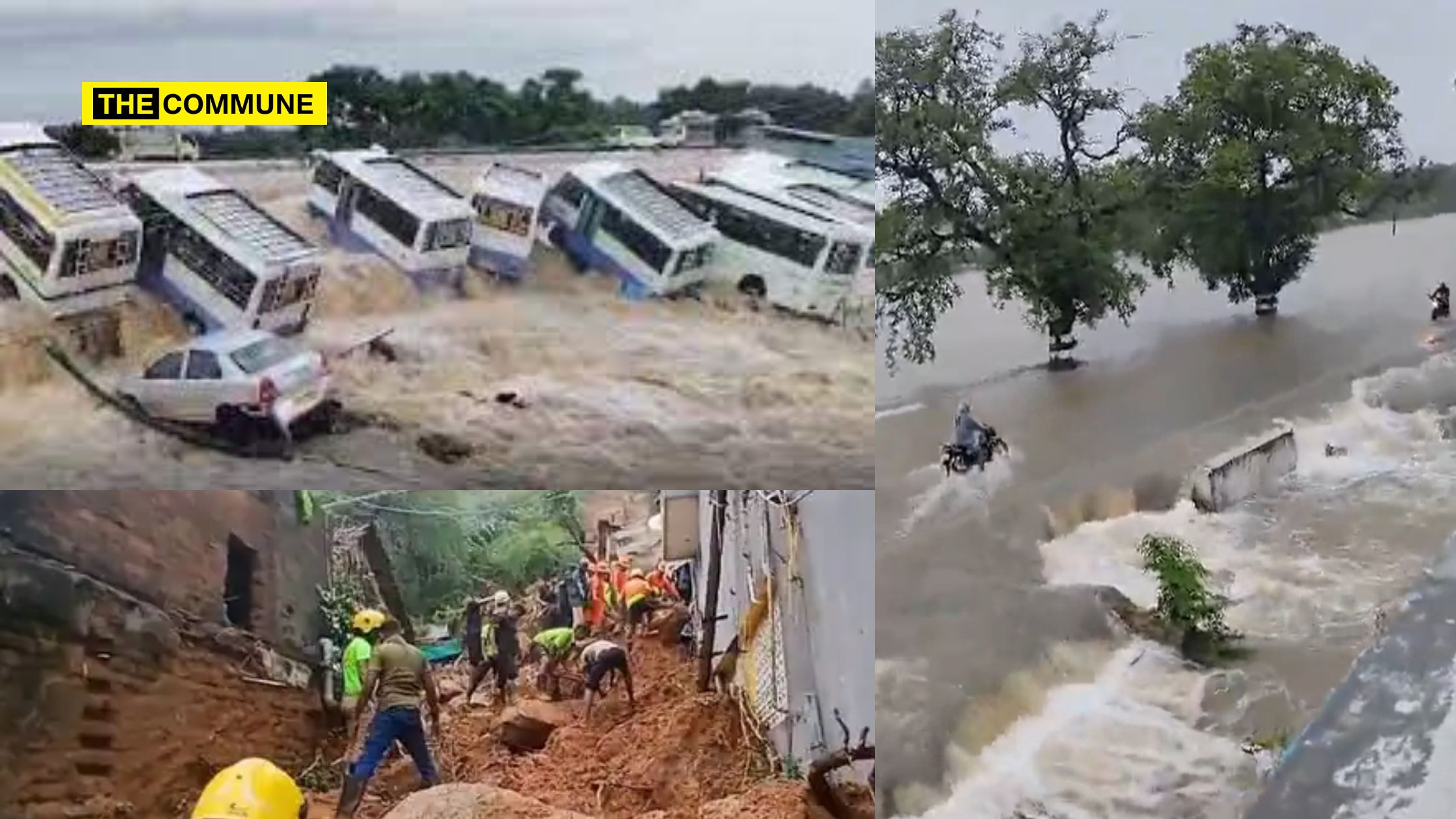As a devastating cyclone wreaks havoc, leaving a trail of destruction in its wake, the sheer force and fury of nature's wrath become impossible to ignore.

Cyclone Fengal Unleashes Devastation In Krishnagiri And Tiruvannamalai - Source thecommunemag.com
Editor's Notes: "Destructive Cyclone Fury Unleashes Havoc, Leaving Devastation In Its Wake" has published today date given the recent events and the urgent need for awareness and preparedness, it is crucial to delve into the destructive power of cyclones and the devastation they can leave behind.
Through meticulous analysis, extensive research, and a deep understanding of the topic, we have meticulously crafted this comprehensive guide to "Destructive Cyclone Fury Unleashes Havoc, Leaving Devastation In Its Wake". Our aim is to provide our readers with the most up-to-date information, expert insights, and practical advice, empowering them to make informed decisions and stay safe in the face of these natural disasters.
Key Differences or Key Takeaways:
Transition to main article topics:
FAQ
Fueled by sustained high winds and relentless rainfall, Cyclone Fury has unleashed a trail of destruction, leaving a wake of devastation. To provide clarity and address public concerns, we have compiled a list of frequently asked questions and their corresponding answers.

Premium Photo | Majestic Creatures Fury Godzilla Unleashes Havoc on - Source www.freepik.com
Question 1: What is the current status of Cyclone Fury?
As of the latest update, Cyclone Fury has weakened to a cyclonic storm. However, authorities emphasize the continued threat posed by heavy rainfall and potential flooding. Coastal areas remain on high alert, as storm surges and high waves may occur.
Question 2: What areas have been most severely impacted?
The coastal regions have borne the brunt of Cyclone Fury's fury, with widespread damage to infrastructure, homes, and businesses. Power outages, disrupted communication networks, and impassable roads have exacerbated challenges for residents and relief efforts.
Question 3: What are the immediate needs and priorities?
Ensuring the safety and well-being of affected communities is paramount. Immediate priorities include providing shelter, food, clean water, and medical assistance to those displaced or rendered vulnerable. Restoring essential services, such as electricity and communication, is also crucial.
Question 4: What long-term recovery measures are being planned?
Rehabilitation and reconstruction efforts will be extensive. Affected areas will require rebuilding and repairing infrastructure, restoring livelihoods, and providing support to individuals and families impacted by the cyclone. Collaboration between government agencies, aid organizations, and local communities will be essential for long-term recovery.
Question 5: How can the public assist in the relief efforts?
Financial contributions to reputable aid organizations directly support the provision of essential aid and services. Volunteering time and skills to assist with relief efforts can also make a meaningful difference. Follow official updates and advisories to stay informed and avoid spreading misinformation.
Question 6: What lessons can be learned from Cyclone Fury?
Cyclone Fury serves as a stark reminder of the importance of preparedness and disaster risk reduction. Robust early warning systems, evacuation plans, and resilient infrastructure can mitigate the impact of future events. Strengthening community resilience through awareness and education will also play a crucial role in minimizing the effects of natural disasters.
For more comprehensive information on Cyclone Fury and the ongoing relief efforts, refer to the original news article: Destructive Cyclone Fury Unleashes Havoc, Leaving Devastation In Its Wake
Tips

Menacing Vortex: A Destructive Tornado Unleashes Chaos Royalty-Free - Source cartoondealer.com
The cataclysmic cyclone has unleashed a torrent of devastation, leaving communities reeling in its aftermath. Amidst the wreckage and despair, it is imperative to prioritize safety and resilience. Here are essential tips to navigate this perilous time:
Tip 1: Monitor Weather Updates and Official Advisories
Stay abreast of the latest weather forecasts and heed all official advisories. Avoid venturing outdoors during periods of heightened risk and seek shelter immediately upon receiving evacuation orders.
Tip 2: Secure Loose Objects
Strong winds can turn innocuous items into dangerous projectiles. Securely fasten or bring indoors any loose objects outside, such as patio furniture, grills, and garden tools.
Tip 3: Protect Windows and Doors
Cover windows and doors with shutters, plywood, or other protective materials to prevent shattering and reduce wind infiltration. Consider reinforcing windows with additional bracing.
Tip 4: Prepare an Emergency Kit
Assemble an emergency kit containing essential supplies such as non-perishable food, clean water, first-aid materials, batteries, a flashlight, and a portable radio. Keep the kit readily accessible.
Tip 5: Protect Vehicles
If possible, park vehicles in a garage or covered area. If no suitable shelter is available, remove loose items from the interior and secure the vehicle with tie-downs or parking brakes.
Tip 6: Stay Informed and Connected
Stay connected with local authorities and trusted news sources for up-to-date information and guidance. Charge electronic devices fully and have backup batteries handy.
Tip 7: Respect Evacuation Orders
If authorities issue an evacuation order, obey it promptly without hesitation. Do not attempt to ride out the storm in areas that may be compromised.
Tip 8: Support Your Community
In the aftermath of the storm, offer assistance to those in need, such as providing shelter, food, or emotional support. Emergencies often foster a sense of unity and resilience.
By adhering to these crucial tips, individuals can mitigate the potential risks and navigate the aftermath of the catastrophic cyclone with enhanced safety and preparedness.
Destructive Cyclone Fury Unleashes Havoc, Leaving Devastation In Its Wake
Destructive cyclones unleash immense fury, leaving behind a trail of devastation. Understanding the key aspects of these destructive weather events is crucial for effective preparedness and mitigation.
- Intense Winds: Cyclones are characterized by extremely high wind speeds, capable of causing widespread damage to infrastructure and uprooting trees.
- Torrential Rain: Accompanying cyclones, torrential rainfall can lead to flash flooding, landslides, and infrastructure collapse.
- Storm Surge: Coastal areas are particularly vulnerable to the impact of storm surge, a wall of water that can cause extensive damage and loss of life.
- Infrastructure Destruction: Cyclones can cripple critical infrastructure, including power lines, communication networks, and transportation routes.
- Economic Devastation: The economic impact of cyclones can be significant, affecting businesses, agriculture, and tourism.
- Humanitarian Crisis: Cyclones often result in widespread displacement, food shortages, and health risks, leading to humanitarian emergencies.
In conclusion, cyclones are complex weather phenomena with devastating consequences. By understanding the key aspects of these destructive events, communities can develop strategies to mitigate risks, save lives, and enhance resilience.

Apocalyptic Fury: Giant Tsunami Waves and Dark Sky Set Dramatic - Source www.dreamstime.com

(best quality,4k,8k,highres,masterpiece:1.2) - SeaArt AI - Source www.seaart.ai
Destructive Cyclone Fury Unleashes Havoc, Leaving Devastation In Its Wake
Cyclones, powerful rotating storms, unleash a devastating fury that leaves a trail of destruction in their wake. The destructive force of these storms stems from their intense winds, which can reach speeds of over 150 miles per hour. These winds tear through communities, uprooting trees, leveling structures, and disrupting infrastructure.

Menacing Vortex: A Destructive Tornado Unleashes Chaos Royalty-Free - Source cartoondealer.com
The effects of cyclones extend beyond the immediate impact of the storm. The devastation they cause can lead to long-term consequences, such as disruption of essential services, displacement of populations, and damage to ecosystems. In coastal areas, storm surges can cause catastrophic flooding, while inland regions may experience severe flooding and mudslides.
Understanding the connection between cyclones and the havoc they wreak is crucial for developing effective mitigation strategies. Accurate forecasting and early warning systems can save lives and property by providing ample time for evacuation and preparation. Additionally, resilient infrastructure, such as reinforced buildings and wind-resistant power lines, can withstand the impact of cyclones, minimizing damage.
The devastating effects of cyclones highlight the urgent need for action to address climate change, a major contributing factor to the increasing frequency and intensity of these storms. Transitioning to renewable energy sources, reducing greenhouse gas emissions, and implementing sustainable land-use practices are essential steps towards mitigating the impacts of cyclones and safeguarding communities at risk.
| Cyclone Impacts | Consequences |
|---|---|
| High winds | Uprooted trees, damaged structures, power outages |
| Storm surges | Flooding, coastal erosion, saltwater intrusion |
| Flooding and mudslides | Infrastructure damage, displacement of populations, loss of crops |
| Disruption of essential services | Lack of access to healthcare, electricity, water |
| Damage to ecosystems | Loss of biodiversity, impaired ecosystem services |
Conclusion
The destructive power of cyclones serves as a stark reminder of the urgency to address climate change and prioritize disaster preparedness. Through a combination of improved forecasting, resilient infrastructure, and mitigation efforts, we can minimize the devastating impacts of these storms and safeguard communities at risk.
The devastating legacy of cyclones underscores the importance of international cooperation and knowledge sharing. By collaborating on research, early warning systems, and disaster relief efforts, we can enhance our global capacity to respond effectively to these catastrophic events. Investing in climate resilience is an investment in the future, protecting lives, livelihoods, and the integrity of our planet.
